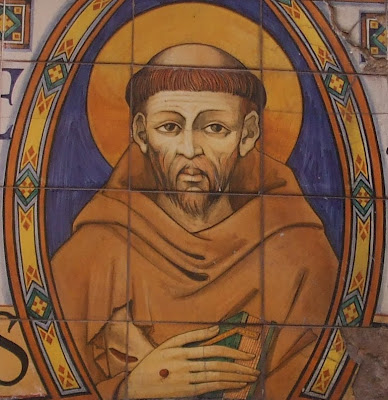 |
| "St. Luke" by Master Theodoric (14th cent) painted on the upper section of wall in the Chapel of the Holy Cross in Karlstein Castle near Prague. |
St. Luke is the writer of the Gospel and the Acts of the Apostles, and was referred to by St. Paul as our "beloved physician.” We know a few other facts about Luke's life from Scripture and from early Church historians.
Luke was most likely born a Greek Gentile. In his writings we can see an emphasis on Gentiles, and on the fact that Jesus came for Jew and Gentile alike. It is only in his Gospel that we hear the parable of the Good Samaritan, that we hear Jesus praising the faith of Gentiles such as the widow of Zarephath and Naaman the Syrian, and that we hear the story of the one grateful leper who is a Samaritan.
In our day, it would be easy to assume that someone who was a doctor would be fairly well to do, but it is more likely that Luke had been born as a slave, and later was able to secure his freedom. It was very common for families to educate slaves in medicine so that they would have a resident family physician.
In the Acts of the Apostles we see that St. Luke was very often a companion to St. Paul in the missionary journeys, and in Acts he uses language from time to time which says “We did so and so,” indicating that he was there. Luke was a loyal friend who stayed with St. Paul when he was imprisoned in Rome. After everyone else had deserted Paul in his final imprisonment and sufferings, it was Luke who remained with Paul to the end: "Only Luke is with me" (2 Timothy 4:11).
St. Luke's inspiration and information for his Gospel and Acts came from his close association with St. Paul. St. Luke also had a special connection with the Blessed Virgin Mary, and there are many things in his Gospel that could have come only through conversations with her. For instance, it is only in Luke's Gospel that we hear the story of the Annunciation, of Mary's visit to Elizabeth including the Magnificat, of the Presentation in the Temple, and the story of Jesus' disappearance in Jerusalem. It is in Luke’s Gospel that we hear the Scriptural parts of the Hail Mary: "Hail, full of grace," which was spoken at the Annunciation, and "Blessed are art thou amongst women, and blessed is the fruit of thy womb," which was spoken by her cousin Elizabeth – all recorded by St. Luke.
Forgiveness and God's mercy to sinners – Jew and Gentile alike – is the theme that runs through Luke’s Gospel. It’s only from St. Luke that we hear the story of the Prodigal Son welcomed back by the overjoyed father. Only in Luke do we hear the story of the forgiven woman disrupting the feast by washing Jesus' feet with her tears. Throughout Luke's Gospel, we see Jesus welcoming those who seek God's mercy.
He is often shown with an ox or a calf because these are the symbols of sacrifice -- the sacrifice Jesus made for all the world. St. Luke is the patron of physicians and surgeons.
Almighty God, who didst call Saint Luke, whose praise is in the Gospel, to be an Evangelist and physician of the soul: may it please thee; that, by the wholesome medicines of the doctrine delivered by him, all the diseases of our souls may be healed; through the merits of Jesus Christ thy Son our Lord, who liveth and reigneth with thee, in the unity of the Holy Spirit, ever one God, world without end. Amen.






.jpg)





